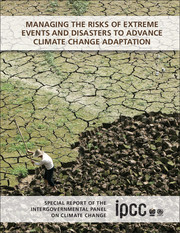 Managing the Risks of Extreme Events and Disasters to Advance Climate Change Adaptation
Managing the Risks of Extreme Events and Disasters to Advance Climate Change Adaptation Book contents
- Frontmatter
- Contents
- Section I
- Section II
- Section III
- Chapter 1 Climate Change: New Dimensions in Disaster Risk, Exposure, Vulnerability, and Resilience
- Chapter 2 Determinants of Risk: Exposure and Vulnerability
- Chapter 3 Changes in Climate Extremes and their Impacts on the Natural Physical Environment
- Chapter 4 Changes in Impacts of Climate Extremes: Human Systems and Ecosystems
- Chapter 5 Managing the Risks from Climate Extremes at the Local Level
- Chapter 6 National Systems for Managing the Risks from Climate Extremes and Disasters
- Chapter 7 Managing the Risks: International Level and Integration across Scales
- Chapter 8 Toward a Sustainable and Resilient Future
- Chapter 9 Case Studies
- Section IV
- Index
- References
Chapter 5 - Managing the Risks from Climate Extremes at the Local Level
from Section III
Published online by Cambridge University Press: 05 August 2012
- Frontmatter
- Contents
- Section I
- Section II
- Section III
- Chapter 1 Climate Change: New Dimensions in Disaster Risk, Exposure, Vulnerability, and Resilience
- Chapter 2 Determinants of Risk: Exposure and Vulnerability
- Chapter 3 Changes in Climate Extremes and their Impacts on the Natural Physical Environment
- Chapter 4 Changes in Impacts of Climate Extremes: Human Systems and Ecosystems
- Chapter 5 Managing the Risks from Climate Extremes at the Local Level
- Chapter 6 National Systems for Managing the Risks from Climate Extremes and Disasters
- Chapter 7 Managing the Risks: International Level and Integration across Scales
- Chapter 8 Toward a Sustainable and Resilient Future
- Chapter 9 Case Studies
- Section IV
- Index
- References
Summary
Executive Summary
Disasters are most acutely experienced at the local level (high agreement, robust evidence). The reality of disasters in terms of loss of life and property occurs in local places and to local people. These localized impacts can then cascade to have national and international consequences. In this chapter, local refers to a range of places, social groupings, experience, management, institutions, conditions, and sets of knowledge that exist at a sub-national scale. [5.1]
Developing strategies for disaster risk management in the context of climate change requires a range of approaches, informed by and customized to specific local circumstances (high agreement, robust evidence). These differences and the context (national to global, urban to rural) in which they are situated shape local vulnerability and local impacts. [5.1]
The impacts of climate extremes and weather events may threaten human security at the local level (high agreement, medium evidence). Vulnerability at the local level is attributed to social, political, and economic conditions and drivers including localized environmental degradation and climate change. Addressing disaster risk and climate extremes at the local level requires attention to much wider issues relating to sustainable development. [5.1]
While structural measures provide some protection from disasters, they may also create a false sense of safety (high agreement, robust evidence). Such measures result in increased property development, heightened population density, and more disaster exposure. Current regulations and design levels for structural measures may be inadequate under conditions of climate change. [5.3.2]
- Type
- Chapter
- Information
- Managing the Risks of Extreme Events and Disasters to Advance Climate Change AdaptationSpecial Report of the Intergovernmental Panel on Climate Change, pp. 291 - 338Publisher: Cambridge University PressPrint publication year: 2012
References
- 37
- Cited by
